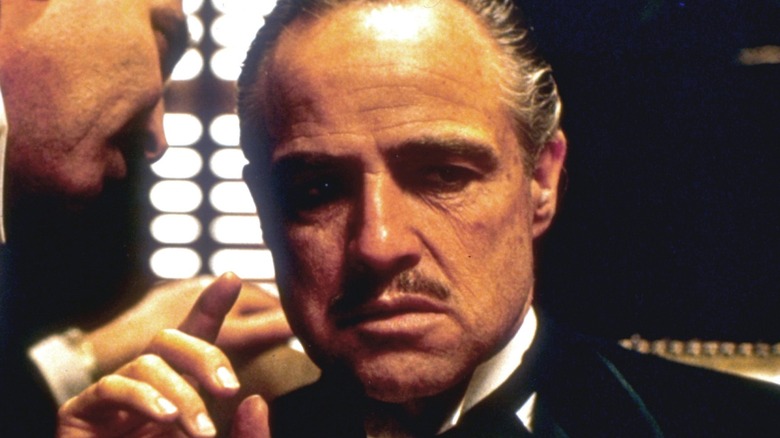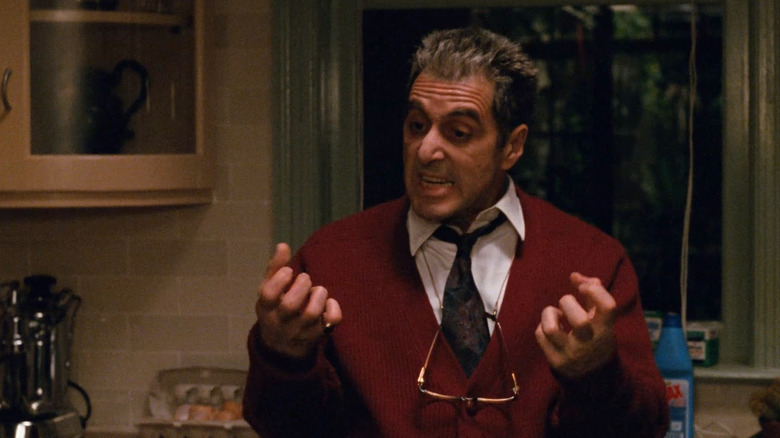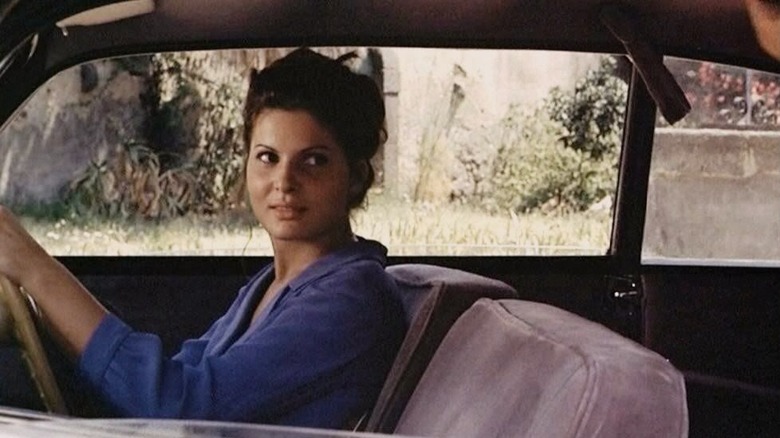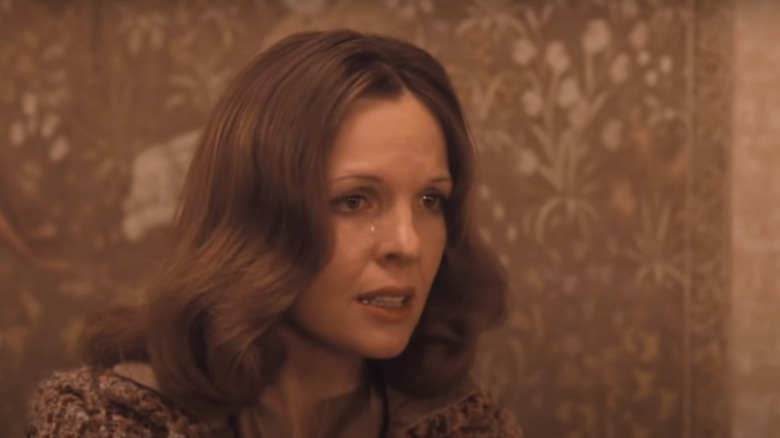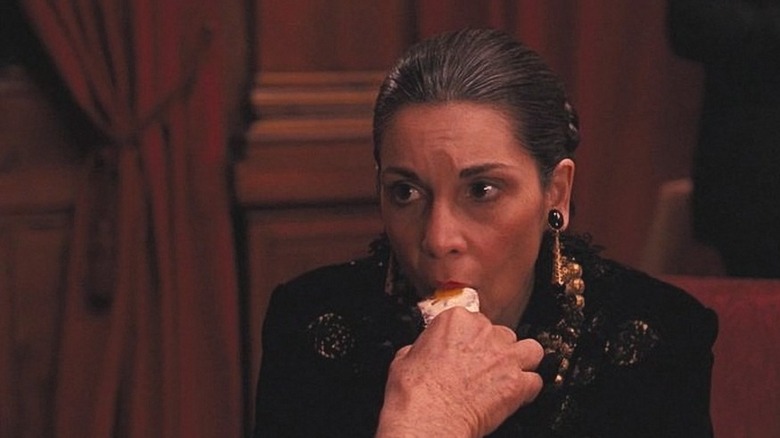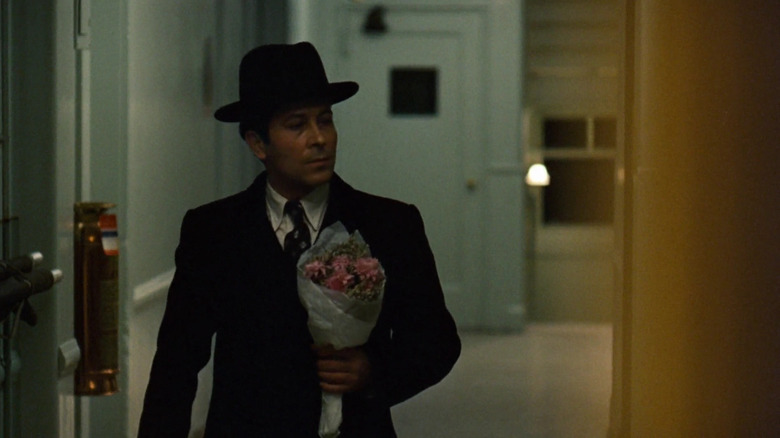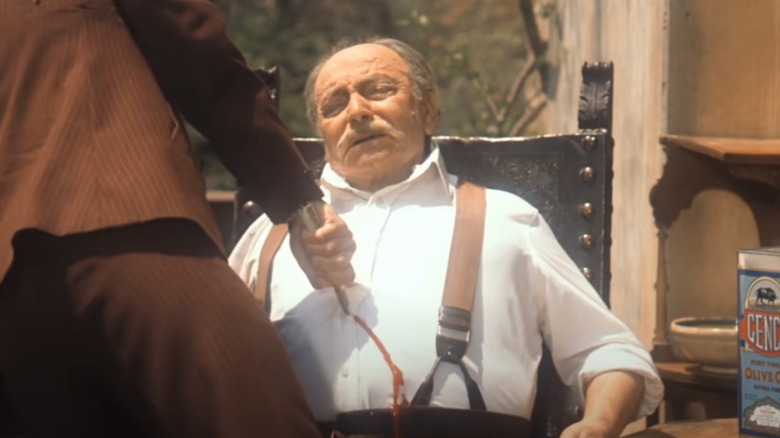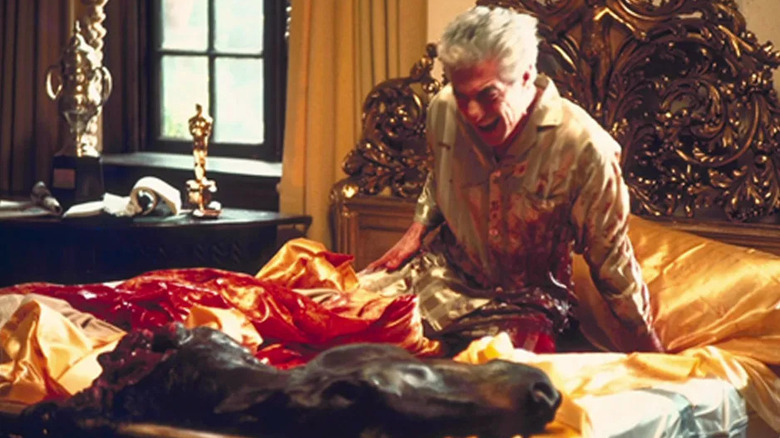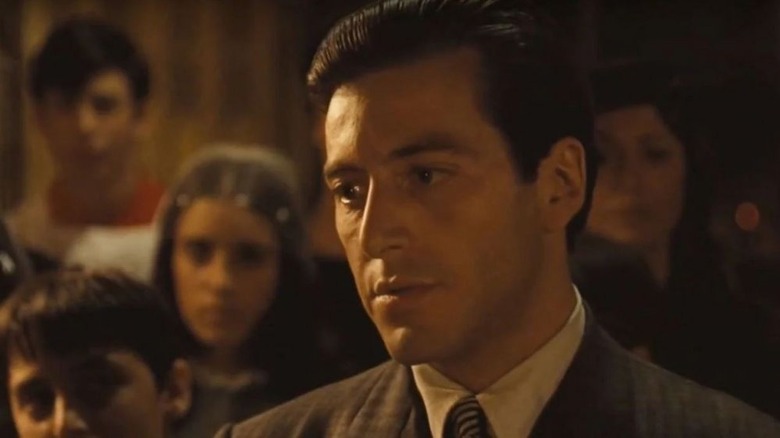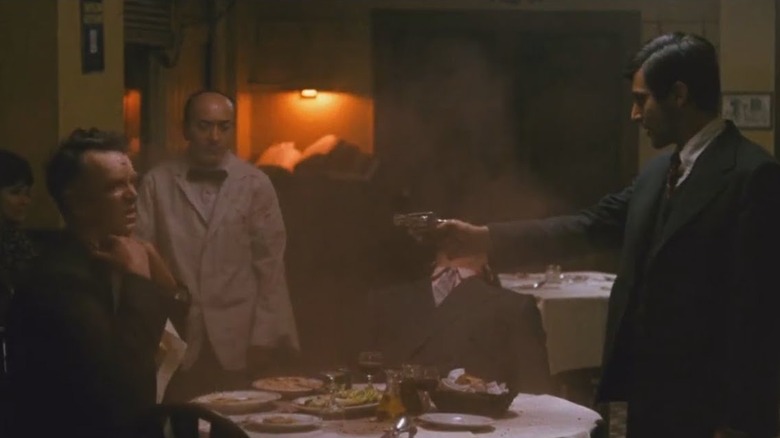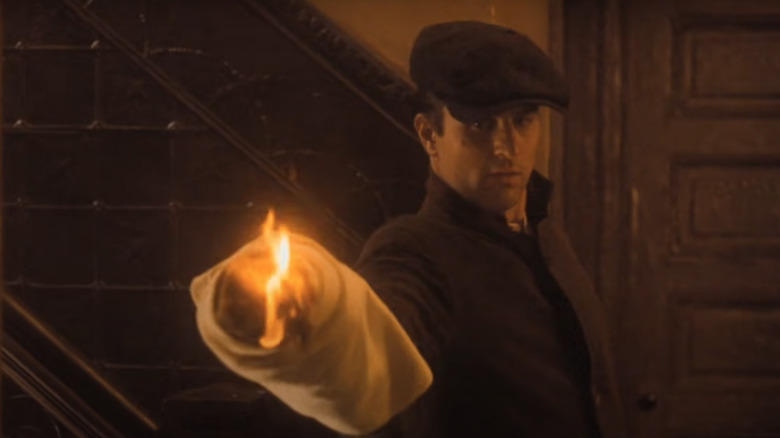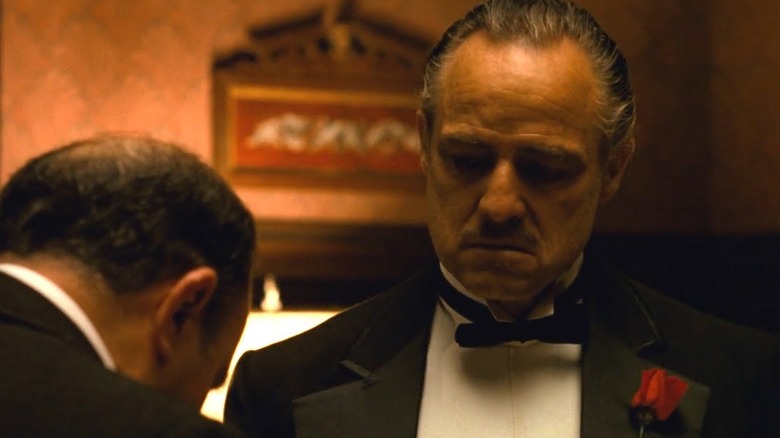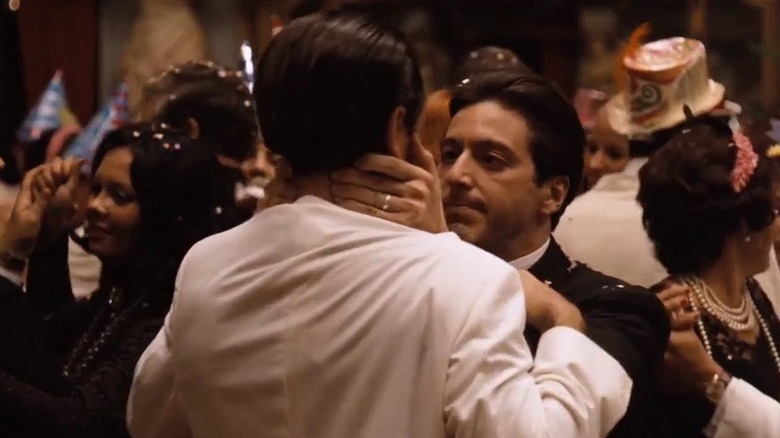12 Most Memorable Moments From The Godfather Trilogy
"The Godfather" trilogy is one of the most famous, most beloved, and most emulated film franchises in cinematic history. Mining from the novel by Mario Puzo, director Francis Ford Coppola made three films about the lives of an Italian American mob family from the 1940s through the 1970s: 1972's "The Godfather," 1974's "The Godfather Part II," and 1990's "The Godfather Part III."
The series stars Marlon Brando as crime boss and Godfather, Vito Corleone. Al Pacino plays his youngest son Michael who, at first, is hesitant to join the family business, but whose transformation into the Godfather himself forms the backbone of the series. In the first film, James Caan plays the eldest son Santino, also called "Sonny," Robert DuVall plays family consigliere and adopted son Tom Hagan, John Cazale plays awkward son Fredo, and Talia Shire plays the family daughter, Connie. Diane Keaton plays Kay Adams, Michael's girlfriend and eventual wife. In the second film, Robert DeNiro joins the cast playing a younger Vito Corleone as a budding mobster in 1917. The second film also travels to Havana, Cuba and Lake Tahoe as Michael solidifies himself as a mob boss. In the third film, a much older Michael tries to go legit, and he embraces a new heir, but can never escape the reality he created.
"The Godfather" trilogy is a sweeping, bloody, violent, tense, and epic three movies with some incredibly memorable moments. Here are the best 12.
Michael's most famous line (The Godfather Part III)
This mention is really more of an ode to Al Pacino's intense and occasionally ham-fisted acting in "The Godfather Part III" than a memorable scene. But, it still makes for one of the most copied, impersonated, and revisited moments of the entire franchise. Michael is older and slower in the third film, but along with his cozy red grandpa-esque cardigan and dangling reading glasses, he still maintains his brutality.
The scene comes after Michael, having attempted to make it in the world as a legitimate businessman without the influence of his mafia family and connections, finds that other mobsters have double-crossed him in an attempt to thwart his goals. For some reason, Michael had his heart set on doing something outside the confines of his mobster past, perhaps to impress his innocent daughter Mary (Sofia Coppola), perhaps as a promise kept to his wife Kay, or perhaps out of his own vanity. But when Michael realizes he'll never be able to escape the mob life or its influences, he gives a quiet yet intimidating speech that culminates in the famous and oft-repeated line: "Just when they thought I was out, they pull me back in!"
With a thunderstorm raging in the background, and lightning flashing through the windows, Michael begins to suffer a diabetic stroke, screaming for his dead brothers and physically unable to control himself. The scene is simultaneously frightening and heartbreaking.
The death of Apollonia (The Godfather)
One of the bigger surprises of the entire "Godfather" franchise, the death of Michael Corleone's Italian wife Apollonia (Simonetta Stefanelli) is one of the biggest tragedies of the series. Having fled to Italy to avoid revenge after he kills rival gang boss Sollozzo, Michael spends his days roaming Sicily with a couple of bodyguards, walking with sheep, lounging at cafés, and generally avoiding drama. But when he sees Apollonia on a walk, he can't get her out of his head. After an extremely formal courting process, the two fall in love and get married.
But Michael should have known that the rival gangs back in America weren't going to let him have his moment of happiness. After teaching Apollonia to drive, Michael plans a small getaway for the two of them. But while Apollonia hops in the front seat of the car, Michael notices one of his bodyguards, Fabrizio, sulking away. At that moment he knows disaster is imminent.
The car explodes as soon as Apollonia turns the key, a bomb intended to kill Michael taking the life of his wife. It's this moment that really turns Michael into a gangster. One could argue killing Sollozzo was just a favor to his family, something that he could help out with. But returning to America, Michael has revenge on his mind, and fully embraces his role in the family.
Kay comes clean (The Godfather Part II)
The role of Kay (Diane Keaton) in the "Godfather" franchise is an interesting one, since women of the franchise don't have much agency. As the first film opens, Michael is trying to convince his lady friend that what his family does and believes isn't necessarily what he does and believes. Their separation when Michael is away hiding in Sicily should have been Kay's first clue that was a lie, but they marry and have two kids. Kay's realization that Michael really is as violent, scheming, and brutal as the rest of his family comes at the end of "The Godfather," when she notices Michael's minions kissing his hand as the door to his office closes ominously.
Obviously, Kay is onto everything in "The Godfather Part II," and when she tries to leave Michael and take custody of their two kids, Michael tries to assuage her by helping her over her "miscarriage." But Kay comes clean in her most memorable and powerful scene: It wasn't a miscarriage at all, she had an abortion. Rather than bring another one of Michael's sons into this Sicilian life of crime and brutality, she chose to have an abortion. "It was an abortion Michael, just like our marriage is an abortion," Kay says, "I didn't want your son, Michael, I wouldn't bring another one of your sons into this world." During her confession, Michael violently strikes Kay, solidifying their inevitable divorce.
Connie kills with cannoli (The Godfather Part III)
Speaking of female characters with not a lot to do, one of the more satisfying elements of "The Godfather Part III" is watching Michael's sister Connie (Talia Shire) grow from an abused woman into a powerful influence on the Corleone family herself. "The Godfather Part I" opens with her wedding, a scene that we'll get to later on this list for its own memorability. But Connie's marriage to Carlo is plagued by his physical abuse and cheating. Connie in the first movie is a victim whose sole purpose in the film seems to be that awful things happen to her. In "The Godfather Part II," reeling from Carlo's death at the hands of Michael's goons, she spirals into meaningless relationships and becomes a social climber and big spender, with no real roots.
But in "The Godfather Part III," Connie plants herself firmly in the Corleone family's doings. She influences Michael to bring Sonny's illegitimate son Vincent (Andy Garcia) into the family, she orders the hit on Joey Zasa, and basically becomes Michael's second in command. But her most memorable scene has to do with her own godfather, Don Altobello. After Connie learns that Don Altobello has been the mastermind behind attacks on her family, she brings a poisoned cannoli, his favorite dessert, to her brother Anthony's opera debut. Altobello is suspicious, but to assuage his fears, Connie takes one very intentional lick of the filling. Altobello dies during the performance, as Connie deviously looks on from her seat.
Tension at the hospital (The Godfather)
One of the most tense and brilliantly shot sequences in the whole "Godfather" trilogy takes place in a hospital where not much happens, but yet again, so much happens. After being ambushed on the street and recovering from gunshot wounds, Vito lies in a hospital bed completely vulnerable. When Michael decides to visit, he slowly walks the claustrophobic hallways of the hospital, taking in the gray-green walls and turning corner after corner looking for his father's room. Watching Michael cautiously turn each corner feels like waiting for another ambush, but he arrives at his father's room only to find that his bodyguards have abandoned him. Michael immediately knows what's up and recruits the nurse to help him move his father to a different room.
Michael turns back to the maze of hallways as he senses another presence. Another man slowly ascends the stairs, as Michael waits to take action. When the man is revealed as Enzo, the baker loyal to Vito, Michael recruits him to stand outside with him as a guard while opposing gang assassins slowly approach in a car. The scene is long, tense, silent, and riveting. Michael's assertion to his dad, "Just lie here, Pop, I'm with you now. I'm with you," marks a turning point as Michael steps into the family business after trying to stay out of it for so long.
Vito kills Don Ciccio (The Godfather part II)
The opening of "The Godfather Part II" introduces us to a little Vito Corleone, born in Sicily as Vito Andolini. After refusing to bow to the local mobster, Don Ciccio, Vito's father, brother, and mother are killed, while family friends help smuggle Vito onto a boat sailing for America. Little Vito sets eyes on the Statue of Liberty as his ship pulls into America in 1901, and he has his surname accidentally changed to that of his hometown.
In 1923, as a successful olive oil businessman and budding mobster, Vito Corleone returns to Sicily to confront the man who took the lives of his family members. At this point, Don Ciccio is old and mostly deaf and blind. He doesn't recognize Vito or know his name, so he begs Vito to lean in a bit closer. Vito uses this as his opportunity to shove a knife into Ciccio's bloated stomach and drag it up to his chest. The brutal murder is enough to make anyone wince and squirm as they watch the scene, and the violence is really stomach-churning. But, the moment solidifies adult Vito's emergence as a gangster, and someone not to be reckoned with on either side of the Atlantic.
A gifted horse (The Godfather)
It's kind of alarming for a movie to have such a disturbing scene so early in the film, but that's the "Godfather" franchise for you. In the film's opening scene, Vito's nephew, singer Johnny Fontane (Al Martino), asks for help landing an acting role in a movie. Tom Hagan approaches the studio boss, Jack Woltz (John Marley), asking for the favor of giving Fontaine a chance. Woltz refuses. While there, however, Hagan takes note of Woltz's prized racehorse, Khartoum.
After his refusal, Woltz wakes up in the morning in a giant bed adorned with golden sheets, but he feels something warm and wet at his feet. He flips off the covers to reveal the severed head of his beloved horse, soaking his bedsheets in blood and imprinting on his brain as absolute nightmare fuel. Woltz complies after that, of course, and the scene shows just how violent and vicious the Corleone family can be. It's a pretty ominous introduction, but "The Godfather's" severed horse head scene has been emulated, copied, and spoofed for decades.
The baptism (The Godfather)
By the end of the first film in the trilogy, Michael Corleone has solidified himself as the new Godfather, and needs to take appropriate action to solidify that stance. At the baptism of his sister Connie's baby, Michael stands as godfather, ready to take on the role of protector and guardian of the child. The priest assertively asks Michael if he renounces evil, and if he renounces Satan, yet each time he replies yes is juxtaposed against actions that contradict his claim. All across the country, the heads of the five families are murdered by Michael's hitmen. Mobster Moe Greene gets shot in the eye while on a massage table, and formerly beloved member of the family, Tessio, gets his comeuppance as well.
As the baby cries and organ music plays in the background, the scene cuts to moments of gunshots and blood. Michael maintains a stoic face as he promises to renounce evil; yet the evil of his choices reverberates into an absolute massacre. It's a hell of a climax to an already bloody film, and even though the killings are certainly evil, it's pretty satisfying to see those that have betrayed and hurt the Corleone family lose the epic battle.
Michael's first kill (The Godfather)
The moment when Michael turns into a killer, and fully a member of the Corleone crime family, also comes pretty early on in "The Godfather." After rival mobster Virgil Sollozzo asks Vito Corleone if he'll go in with him on a narcotics business, Vito refuses, setting off a series of events that includes Vito getting shot, Tom getting kidnapped, and the Tattaglia family joining the war. Michael gets beat up by corrupt cop McClusky and has his jaw wired shut. But when Sollozzo and McCluksy offer to meet, Michael volunteers not only to take the meeting himself, but to kill the two of them for good.
The meeting happens over dinner at an Italian restaurant in The Bronx. Michael struggles to speak through his wired mouth and Sollozzo speaks in Italian, with no subtitles helping the viewer, adding to the disorientation and tension. Pacino's stoic expression and suspicious eye movements here are fun to watch. Michael retrieves a gun from the bathroom left there by Tessio and shoots them both dead. The murder is abrupt and heartless, marking Michael's transition from casual observer of his family's methods to full-on participant.
Vito kills Fannuci (The Godfather Part II)
The combination of flashbacks into Vito's life and the present-day scenes with Michael and family is what makes "The Godfather Part II" so riveting to watch. We can see the influences Vito's young life had on his choices as Godfather, and how he has shaped his children. One of the more riveting scenes is when Vito takes revenge on New York mob boss Don Fanucci (Gastone Moschin). In 1917, when Vito was a young father, he lost his job at a grocer because Fanucci had ordered the owner to hire his own relative. Vito dislikes how Fanucci shakes down fellow Italian immigrants, so he decides to take action.
Vito stalks Fanucci over the rooftops of Little Italy during the Feast of Saint Rocco. As Fanucci makes his way through the crowds and into his apartment, he stops at a broken hallway lamplight that Vito has preemptively loosened. As the fireworks explode outside, Vito fires his gun, killing Fanucci. He then climbs back up to the rooftops where he expertly disposes of pieces of the weapon down various chimneys in order to hide the evidence. The scene is a nail-biter, and yet it's a load of fun to watch the young Vito use his smarts and skill to outwit the cruel mobster.
Meeting the Godfather (The Godfather)
The opening scene of "The Godfather" isn't just one of the most memorable in the franchise, but one of the most memorable in film history. Cloaked in shadows and shot with many a close up, the viewer is introduced to the Godfather on the day of his daughter's wedding. As the party rages on outside, Don Vito Corleone takes meetings with those who need some favors. After all, the Godfather cannot refuse a favor on the day of his daughter's wedding. Here Marlon Brando, dental appliance in his mouth to give him those famous jowls and muffled speech, personifies the Godfather as a quiet powerhouse, a threatening yet helpful presence, one who will do anything for his family. He strokes a fluffy cat while also muttering one of the most famous lines: "I'm going to make him an offer he can't refuse."
As the scene progresses, we learn more about each family member: Michael the noble one returned from war, Tom the adopted brain, Sonny the hot head, Fredo the failure. It's a killer of an introduction not only to the story, but to the family. And the mystery that unfolds as Vito takes in those meetings sets up the intrigue and sequences of events that will reverberate throughout the series.
The kiss of death (The Godfather Part II)
While traveling in Havana, Cuba, Michael figures out that it was his own brother, Fredo, who went behind his back and was responsible for the assassination attempt that occurs earlier in "The Godfather Part II." During a raucous New Year's Eve celebration, Michal approaches Fredo in the crowd, the confetti still falling on their heads and shoulders, grabs him by the head, and plants a kiss on his mouth. The mob boss kiss of death. Still holding Fredo's head, Michael says, "I know it was you, Fredo. You broke my heart. You broke my heart." Fredo sulks away knowing his own fate.
Later, towards the end of the film, Michael has Fredo shot while he's fishing in a little canoe on Lake Tahoe. The scene is sad and quiet, and closes out the film, but the more memorable, perhaps the most of the whole franchise, is when Michael gives Fredo the unwanted kiss. Often repeated throughout pop culture and replicated in other movies, Michaels's kiss of death and the line "You broke my heart" is one of the "Godfather" franchise's most remembered, and perhaps Al Pacino's most iconic scene.
